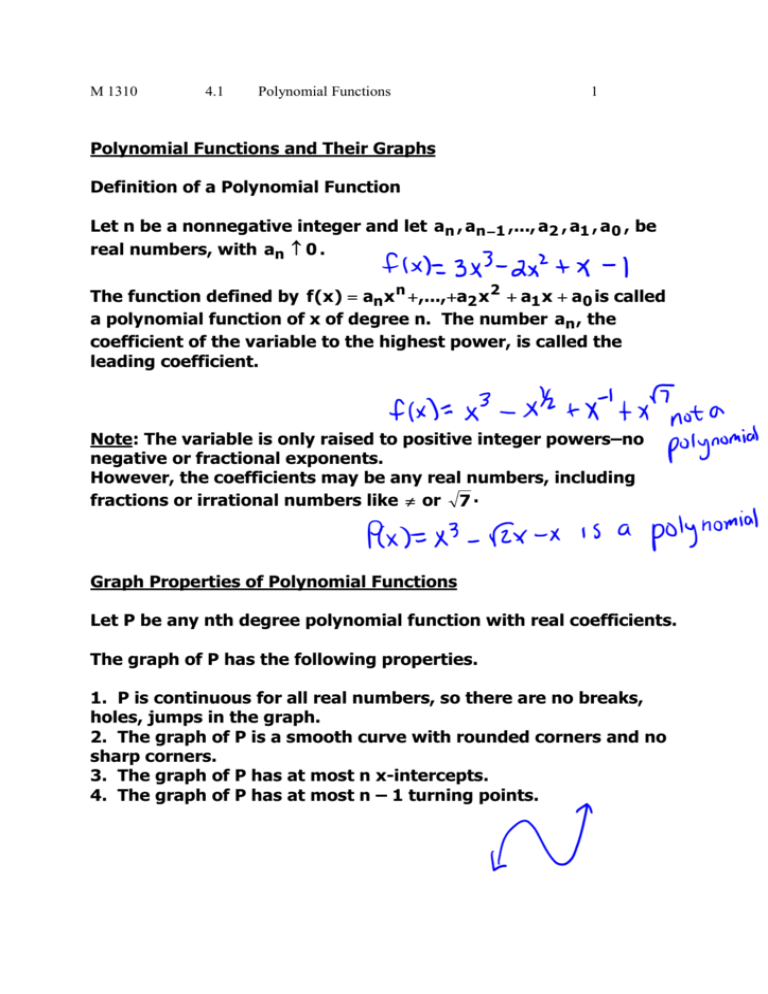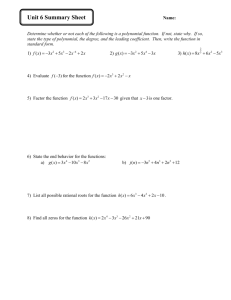Polynomial Functions and Their Graphs Definition of a Polynomial
advertisement

M 1310 4.1 Polynomial Functions 1 Polynomial Functions and Their Graphs Definition of a Polynomial Function Let n be a nonnegative integer and let an , an − 1 ,..., a2 , a1 , a 0 , be real numbers, with an ≠ 0 . The function defined by f ( x ) = an x n + ,...,+ a2 x 2 + a1 x + a0 is called a polynomial function of x of degree n. The number an , the coefficient of the variable to the highest power, is called the leading coefficient. Note: The variable is only raised to positive integer powers–no negative or fractional exponents. However, the coefficients may be any real numbers, including fractions or irrational numbers like π or 7 . Graph Properties of Polynomial Functions Let P be any nth degree polynomial function with real coefficients. The graph of P has the following properties. 1. P is continuous for all real numbers, so there are no breaks, holes, jumps in the graph. 2. The graph of P is a smooth curve with rounded corners and no sharp corners. 3. The graph of P has at most n x-intercepts. 4. The graph of P has at most n – 1 turning points. M 1310 4.1 Polynomial Functions 2 f (x ) = x( x − 2)3 ( x + 1)2 Polynomial Not a polynomial M 1310 4.1 Polynomial Functions 3 Example 1: Given the following polynomial functions, state the leading term, the degree of the polynomial and the leading coefficient. a. P( x ) = 7x 4 − 5 x 3 + x 2 − 7x + 6 b. P( x ) = (3x + 2)( x − 7)2 ( x + 2)3 End Behavior of a Polynomial Odd-degree polynomials look like y = ± x 3 . y = x3 y = −x3 Even-degree polynomials look like y = ± x2 . y = x2 y = − x2 M 1310 4.1 Polynomial Functions 4 Power functions: A power function is a polynomial that takes the form f (x ) = axn , where n is a positive integer. Modifications of power functions can be graphed using transformations. Even-degree power functions: f ( x) = x 4 Odd-degree power functions: f (x) = x 5 Note: Multiplying any function by a will multiply all the y-values by a. The general shape will stay the same. Exactly the same as it was in section 3.4. M 1310 4.1 Polynomial Functions 5 Zeros of a Polynomial Example 2: Find the zeros of the polynomial and then sketch the graph. P( x ) = x 3 − 5 x 2 + 6 x If f is a polynomial and c is a real number for which f (c) = 0 , then c is called a zero of f, or a root of f. If c is a zero of f, then • c is an x-intercept of the graph of f. • (x − c ) is a factor of f. So if we have a polynomial in factored form, we know all of its xintercepts. • every factor gives us an x-intercept. • every x-intercept gives us a factor. M 1310 4.1 Polynomial Functions 6 Example 3: Consider the function f (x ) = −3 x (x − 3)2 (4 − x )4 . Zeros (x-intercepts): To get the degree, add the multiplicities of all the factors: The leading term is: Steps to graphing other polynomials: 1. Factor and find x-intercepts. 2. Mark x-intercepts on x-axis. 3. Determine the leading term. • Degree: is it odd or even? • Sign: is the coefficient positive or negative? M 1310 4.1 Polynomial Functions 7 4. Determine the end behavior. What does it “look like”? Odd Degree Sign (+) Even Degree Sign (+) Odd Degree Sign (-) Even Degree Sign (-) 5. For each x-intercept, determine the behavior. • Even multiplicity: touches x-axis, but doesn’t cross (looks like a parabola there). • Odd multiplicity of 1: crosses the x-axis (looks like a line there). • Odd multiplicity ≥ 3 : crosses the x-axis and looks like a cubic there. M 1310 4.1 Polynomial Functions 8 Note: It helps to make a table as shown in the examples below. 6. Draw the graph, being careful to make a nice smooth curve with no sharp corners. Note: without calculus or plotting lots of points, we don’t have enough information to know how high or how low the turning points are. Example 4: Find the zeros then graph the polynomial. Be sure to label the x intercepts, y intercept if possible and have correct end behavior. P( x ) = x 4 (x − 2 )3 (x + 1)2 M 1310 4.1 Polynomial Functions 9 Example 5: Find the zeros then graph the polynomial. Be sure to label the x intercepts, y intercept if possible and have correct end behavior. P( x ) = x 3 (x + 2 )(x − 3)2 Example 6: Find the zeros then graph the polynomial. Be sure to label the x intercepts, y intercept if possible and have correct end behavior. P( x ) = −2 (x + 1)2 (x − 7)4 (2 x − 10 )5 M 1310 4.1 Polynomial Functions 10 Example 7: Find the zeros then graph the polynomial. Be sure to label the x intercepts, y intercept if possible and have correct end behavior. P( x ) = x 3 + 3x 2 − 4 x − 12 Example 8: Given the graph of a polynomial determine what the equation of that polynomial. M 1310 4.1 Polynomial Functions 11 Example 9: Given the graph of a polynomial determine what the equation of that polynomial.






